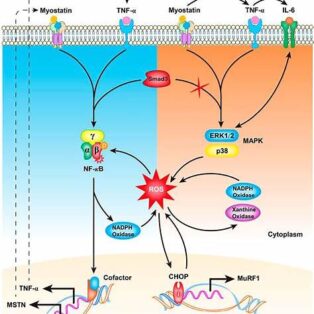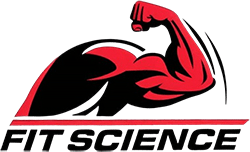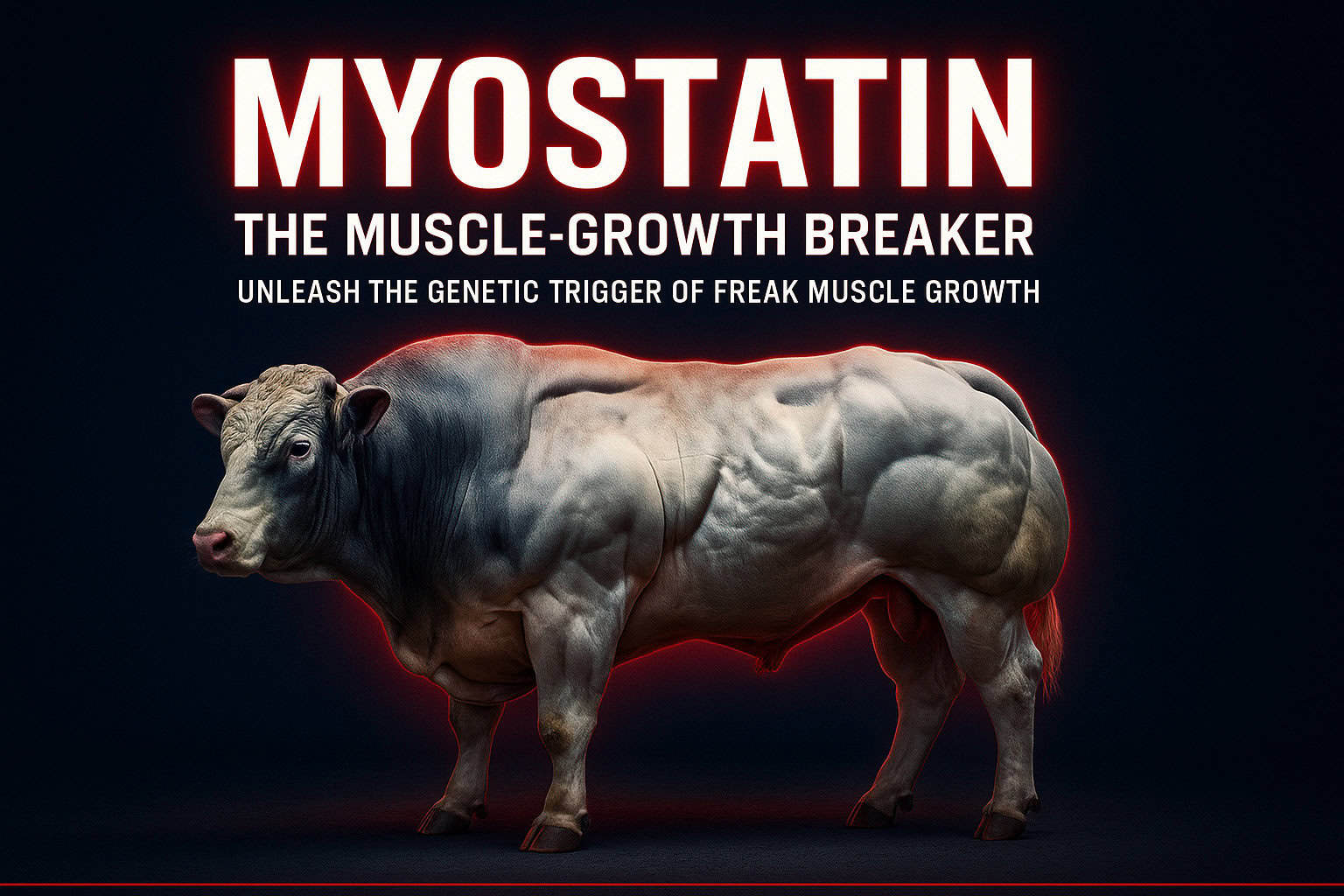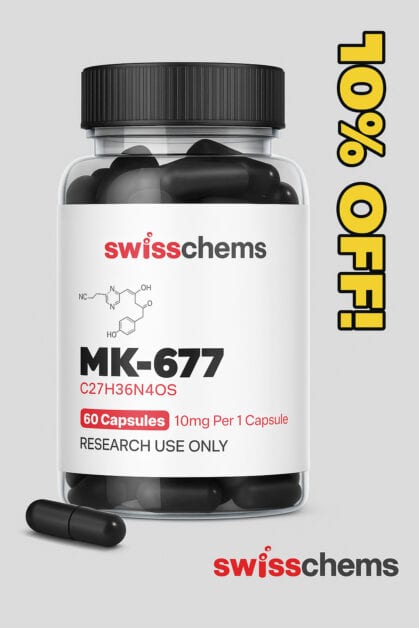💪 The Ultimate Guide to Myostatin: The Muscle Growth Inhibitor Holding You Back—and How to Block It
If you’ve ever wondered why, despite perfect diet, training, and supplements, your muscle growth has a ceiling—meet your invisible enemy: myostatin. This naturally occurring protein plays the role of muscle growth regulator. It’s your body’s internal handbrake, capping how much lean muscle you can build, no matter how dialed-in your stack is.
But what if you could silence it?
This article is your no-BS, science-backed guide to myostatin: how it works, why it exists, and most importantly—how serious bodybuilders are attempting to beat it using cutting-edge compounds known as myostatin blockers.
🧬 What Is Myostatin?

Myostatin, also called GDF-8 (growth differentiation factor 8), is a protein secreted primarily in skeletal muscle cells. It belongs to the TGF-β (transforming growth factor-beta) family—a group of proteins involved in cellular growth and differentiation.
Its sole purpose? To inhibit muscle cell growth and differentiation. Think of it as your body’s internal regulator designed to stop you from gaining too much muscle.
This isn’t a bug—it’s a built-in survival mechanism. From an evolutionary standpoint, large amounts of muscle mass are metabolically expensive to maintain. In harsh environments with food scarcity, being overly muscular could mean a quicker death.
So nature added a safeguard: myostatin.
📉 How Myostatin Limits Muscle Growth
Here’s how it works in the real world of hypertrophy:
-
Muscle cells release myostatin into the bloodstream in proportion to your muscle mass.
-
Myostatin binds to activin type IIB receptors on muscle cells.
-
This binding activates a cascade that inhibits satellite cell activation—the very cells responsible for muscle repair and growth.
-
The result? Less protein synthesis, slower hypertrophy, capped muscle gains.
In animal models, especially mice and cattle, eliminating myostatin has led to extreme muscularity. The famed “mighty mouse” and Belgian Blue cattle are genetically mutated examples where myostatin is either deleted or inactive—resulting in freakish muscle mass without training.
🧪 Why Bodybuilders Want to Inhibit Myostatin
If myostatin blocks growth, logic says that blocking myostatin would remove that cap.
For enhanced bodybuilders and performance athletes, reducing or silencing this protein could mean:
-
Breaking natural plateaus
-
Accelerated lean mass accrual
-
Greater hypertrophy from the same training volume
-
Enhanced recovery and muscle density
The appeal is obvious—but suppressing a central biological control mechanism isn’t risk-free or easy. That’s where myostatin inhibitors come in.
⚗️ How to Reduce or Block Myostatin (And What Actually Works)
There are two main strategies to reduce myostatin:
-
Biological inhibitors: peptides, monoclonal antibodies, and gene therapies.
-
Nutraceutical inhibitors: naturally occurring compounds shown to blunt myostatin to a limited degree.
Let’s break down what science and real-world feedback say about both.
🔬 Peptide and Pharmaceutical Myostatin Blockers
1. Follistatin (FST-344 / Follistatin-344 / FS344)
-
Mechanism: Binds to and neutralizes myostatin directly.
-
Results: Shown to increase muscle mass in rodents by up to 200%. In humans, anecdotal reports show significant gains in muscle density, vascularity, and shape.
-
Forms: Injectable peptide or gene therapy.
-
Real-world feedback: Users report “3D muscle look,” rapid recomposition, and improved pumps even in caloric deficits.
2. ACE-031
-
Mechanism: Acts as a decoy receptor, binding to myostatin and preventing it from signaling muscle cells.
-
Results: In clinical trials, a single ACE-031 dose increased lean body mass by 1 kg in 29 days without training.
-
Status: Clinical development halted due to mild side effects (nosebleeds, gum swelling), but black market interest remains high.
3. YK-11 (Myostatin Modulating SARM)
-
Mechanism: Inhibits myostatin expression while also acting as a partial androgen receptor agonist.
-
Unique factor: YK-11 increases follistatin production inside the muscle—giving it a dual mode of action.
-
Real-world results: Vascularity, dense hard muscle, and fast recomposition when stacked with other SARMs like RAD-140 or LGD-4033.
4. Gene Therapy (AAV-FST or CRISPR-Cas9 Myostatin Knockout)
-
Mechanism: Gene silencing of myostatin expression using viral vectors or gene editing tools.
-
Use case: Still in experimental or underground development. Seen as the future of long-term muscle modulation.
-
Warning: Permanent gene editing carries extreme risks and ethical concerns. Currently not legal or safe for human enhancement use.
🌿 Natural Myostatin Inhibitors
Though less potent, some natural compounds show mild inhibitory effects:
1. Epicatechin (from dark chocolate/green tea)
-
Mechanism: Increases follistatin/myostatin ratio.
-
Human trial results: One study showed a 7% increase in grip strength and higher follistatin levels after 7 days.
-
Dose: 150–200 mg/day.
2. Creatine
-
Mechanism: Mildly downregulates myostatin expression post-exercise.
-
Bonus: Also improves ATP resynthesis and volumization.
-
Not a blocker: But still plays a supporting role in lowering myostatin in the post-training window.
3. Sulforaphane (found in broccoli sprout extract)
-
Mechanism: Activates Nrf2 pathway, shown to reduce myostatin in aging models.
-
Use: 100–200 mg/day of sulforaphane or broccoli sprout concentrate.
🧬 Chart: Natural Myostatin Inhibitors & Muscle Benefits
Here’s a digestible visual summary of evidence-backed natural compounds that help reduce myostatin activity:
| Compound | Mechanism | Human Study Result |
|---|---|---|
| (−)‑Epicatechin | ↑ Follistatin / ↓ Myostatin | +7% grip strength in 7 days institut-myologie.org+2frontiersin.org+2mdpi.com+2 |
| Sulforaphane | Nrf2‑mediated downregulation | Improved muscle function, ↓ myostatin (12 wks) |
| Creatine | ↓ Post‑exercise myostatin | Shown in resistance training |
Visualizing effects like strength improvements and myostatin modulation may help you implement these compounds with clearer perspective.
📊 Myostatin Blockers Comparison Table
| Compound | Mechanism of Action | Type | Effectiveness | Risk Level | Real-World Use |
|---|---|---|---|---|---|
| Follistatin-344 | Binds to and neutralizes myostatin | Peptide | 🔥🔥🔥🔥🔥 | ⚠️⚠️⚠️⚠️ | Widely used in black market cycles |
| ACE-031 | Decoy receptor, binds circulating GDF-8 | Biologic | 🔥🔥🔥🔥 | ⚠️⚠️⚠️ | Rare due to shutdown of trials |
| YK-11 | Boosts follistatin, weak AR agonist | SARM | 🔥🔥🔥 | ⚠️⚠️ | Popular in SARM stacks |
| Epicatechin | Improves FST:GDF-8 ratio | Natural | 🔥 | ✅ Safe | OTC supplement |
| Sulforaphane | Downregulates myostatin via Nrf2 | Natural | 🔥 | ✅ Safe | Long-term use |
| Gene Therapy | Silences myostatin expression | Genetic | 🔥🔥🔥🔥🔥 | 🚨 Extreme | Experimental |
📈 Real-World Muscle Gains: What Users Report
While clinical trials are limited, anecdotal evidence from forums, underground logs, and experimental athletes is compelling:
-
Follistatin users often report 7–10 lbs of lean mass gain in 4–6 weeks, even without bulking diets.
-
YK-11 users stacking with RAD-140 or LGD often claim faster recomp results—sharper definition and muscle roundness in under 8 weeks.
-
Epicatechin and sulforaphane show modest body recomposition effects when paired with hypertrophy training and calorie optimization.
-
Creatine remains a staple, enhancing the environment for reduced myostatin post-training, though not a primary inhibitor.
⚠️ Side Effects and Risks
Suppressing myostatin can lead to unintended consequences:
-
Tendon stress: Muscles may grow faster than tendons adapt, increasing injury risk.
-
Organomegaly: Animal models show risk of organ enlargement if muscle mass expands rapidly.
-
Blood pressure: Some peptides increase vascular resistance.
-
Unknown long-term effects: Especially with gene therapy or systemic follistatin overexpression.
🧠 Final Thoughts: Should You Try to Block Myostatin?
For enhanced athletes or pro bodybuilders chasing that extra 5–10% edge, the concept of breaking past your genetic ceiling by limiting myostatin is tantalizing.
But it’s not for beginners. The risks, sourcing concerns, and biological consequences of interfering with something as foundational as myostatin are real.
If you’re considering it:
-
Get bloodwork before and after use.
-
Track muscle-to-strength ratio to ensure tendons aren’t being outpaced.
-
Stack intelligently—myostatin blockers work best with hypertrophy-driven protocols, not brute force bulking.
For now, compounds like YK-11 and Follistatin-344 offer short-term enhancement, while true genetic inhibition remains the holy grail—but with a heavy price.
📚 Citations and References
-
McPherron AC, Lawler AM, Lee SJ. Regulation of skeletal muscle mass in mice by a new TGF-β superfamily member. Nature.
-
Lee SJ. Genetic analysis of the role of growth factors in muscle development. Proc Natl Acad Sci USA.
-
Whittemore LA et al. Inhibition of myostatin in adult mice increases skeletal muscle mass and strength. Biochem Biophys Res Commun.
-
Allen DL, Cleary AS, et al. Myostatin, a negative regulator of skeletal muscle mass: implications for muscle disease.
-
Latres E, Mastaitis J, et al. Activin A more than myostatin inhibits muscle differentiation and regeneration.
-
Nespoli L, et al. Human study: Epicatechin supplementation increases muscle strength and follistatin levels.
-
ClinicalTrials.gov. ACE-031 studies.
-
Rahimov F, Kunkel LM. The cell biology of disease: Cellular and molecular mechanisms underlying muscular dystrophy.
-
Zampieri S et al. Gene editing and myostatin: risk and future perspectives in athletes.
-
Broccolini A, et al. Myostatin and neuromuscular disorders.










